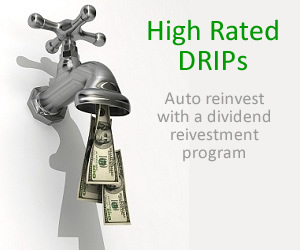Dividend Income Strategy
Use Dividend Income to Increase Your Portfolio
A DRIP, or dividend reinvestment plan, is a simple way to reinvest those monthly or quarterly payments. The company or fund that you are investing in should be able to set this up at your request. Instead of sending you a check when it’s time for them to make their dividend payment, they will reinvest the amount in the same stock or fund that paid the dividend. If your dividend is not enough to purchase a whole share or an even number of shares, you’ll receive a partial share.
 If you decide to take advantage of a DRIP, you’ll soon find that your ROI (return on investment) rate will show a vast improvement. You will be compounding your investment by purchasing additional shares which means that each dividend reinvestment will be slightly larger with each passing DRIP cycle.
If you decide to take advantage of a DRIP, you’ll soon find that your ROI (return on investment) rate will show a vast improvement. You will be compounding your investment by purchasing additional shares which means that each dividend reinvestment will be slightly larger with each passing DRIP cycle.
In some cases, a DRIP may not be available. You can still take advantage of reinvestment options to increase your ROI on your own. While it will take a little more effort on your part, or your portfolio manager’s part, you can use the dividend payments to purchase more of the same stock or invest in different investment vehicles.
Dividend Income Funds Provide an Easy Diversification Option
Some people don’t have the time to analyze the stock market, while others don’t have confidence in their ability to make a smart choice. Regardless of the reason, many people choose to invest in a dividend income fund. This type of investment vehicle does all of the work for you by using professional market analysts to choose a variety of dividend paying stocks to make sure the fund is diversified to reduce the overall risk.
You might choose a dividend income fund for the guaranteed monthly payout. While some funds pay out only the dividends earned during the payment cycle, other funds state that they will pay a certain amount each month. If the fund does not make enough in dividend payments to cover the distribution amount, a portion of the principal will be included. The principal could be a gain earned on a stock that has increased in value or it could be from a stock sold at a loss.
Dividend and Income Taxes
 Even if you reinvest your dividend payments, you must still report the amount on your yearly income tax returns. They will be taxed either as ordinary income or as qualified dividends. To be considered qualified, you “must have held the stock for more than 60 days during the 121-day period that begins 60 days before the ex-dividend date” according to the IRS publication 550. If your regular income tax rate is 25% or more, your qualified dividend payments will be taxed at 15%. Otherwise, your qualified dividend income tax rate will only be 5%.
Even if you reinvest your dividend payments, you must still report the amount on your yearly income tax returns. They will be taxed either as ordinary income or as qualified dividends. To be considered qualified, you “must have held the stock for more than 60 days during the 121-day period that begins 60 days before the ex-dividend date” according to the IRS publication 550. If your regular income tax rate is 25% or more, your qualified dividend payments will be taxed at 15%. Otherwise, your qualified dividend income tax rate will only be 5%.

Some dividend reinvestment plans will off the shares at a small discount to the share price.